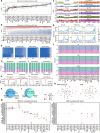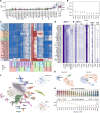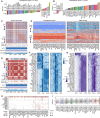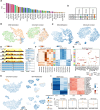This is a preprint.
Human Body Single-Cell Atlas of 3D Genome Organization and DNA Methylation
- PMID: 40196612
- PMCID: PMC11974725
- DOI: 10.1101/2025.03.23.644697
Human Body Single-Cell Atlas of 3D Genome Organization and DNA Methylation
Abstract
Higher-order chromatin structure and DNA methylation are critical for gene regulation, but how these vary across the human body remains unclear. We performed multi-omic profiling of 3D genome structure and DNA methylation for 86,689 single nuclei across 16 human tissues, identifying 35 major and 206 cell subtypes. We revealed extensive changes in CG and non-CG methylation across almost all cell types and characterized 3D chromatin structure at an unprecedented cellular resolution. Intriguingly, extensive discrepancies exist between cell types delineated by DNA methylation and genome structure, indicating that the role of distinct epigenomic features in maintaining cell identity may vary by lineage. This study expands our understanding of the diversity of DNA methylation and chromatin structure and offers an extensive reference for exploring gene regulation in human health and disease.
Conflict of interest statement
Competing interests: J.R.E. is a scientific adviser for Zymo Research Inc., Ionis Pharmaceuticals, and Guardant Health. B.R. is a cofounder and consultant for Arima Genomics Inc. and cofounder of Epigenome Technologies. M.P.S. is a co-founder and the scientific advisory board member of Personalis, SensOmics, Qbio, January AI, Fodsel, Filtricine, Protos, RTHM, Iollo, Marble Therapeutics, Crosshair Therapeutics, NextThought and Mirvie. He is a scientific advisor of Jupiter, Neuvivo, Swaza, Mitrix, Yuvan, TranscribeGlass, Applied Cognition.
Figures






References
-
- Allis C. D., Jenuwein T., The molecular hallmarks of epigenetic control. Nat. Rev. Genet. 17, 487–500 (2016). - PubMed
-
- Tang F., Barbacioru C., Wang Y., Nordman E., Lee C., Xu N., Wang X., Bodeau J., Tuch B. B., Siddiqui A., Lao K., Surani M. A., mRNA-Seq whole-transcriptome analysis of a single cell. Nat. Methods 6, 377–382 (2009). - PubMed
Publication types
Grants and funding
LinkOut - more resources
Full Text Sources
